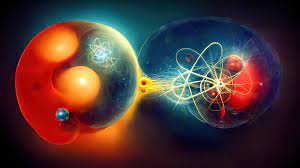- info@udayanam.com
- +91 522-3525290
- Udayanam Institute

Quarks are considered point-like particles, meaning they
have no known substructure or size.
Quarks are classified into six different types or flavors:
Up (u) quark: It has a positive charge of +2/3 elementary
charge and is the lightest among all quarks.
Down (d) quark: It has a negative charge of -1/3 elementary
charge and is also relatively light.
Charm (c) quark: It has a positive charge of +2/3 elementary
charge and is more massive than up and down quarks.
Strange (s) quark: It has a negative charge of -1/3
elementary charge and is more massive than up and down quarks but less massive
than charm and bottom quarks.
Top (t) quark: It has a positive charge of +2/3 elementary
charge and is the most massive of all known quarks.
Bottom (b) quark: It has a negative charge of -1/3
elementary charge and is the second most massive quark after the top quark.
Quarks possess a property known as color charge, which is
related to the strong nuclear force that binds them together within hadrons
(composite particles made of quarks). The three color charges are called red,
green, and blue, and their corresponding antiquarks have anticolor charges:
antired, antigreen, and antiblue. Quarks can combine in groups of three to form
baryons, such as protons and neutrons, or in pairs with antiquarks to form
mesons.
It is essential to note that the study of quarks and other
elementary particles is an active area of research, and new discoveries may
have emerged since my last update. Please consult more recent sources for the
latest information on this topic.
Top of Form